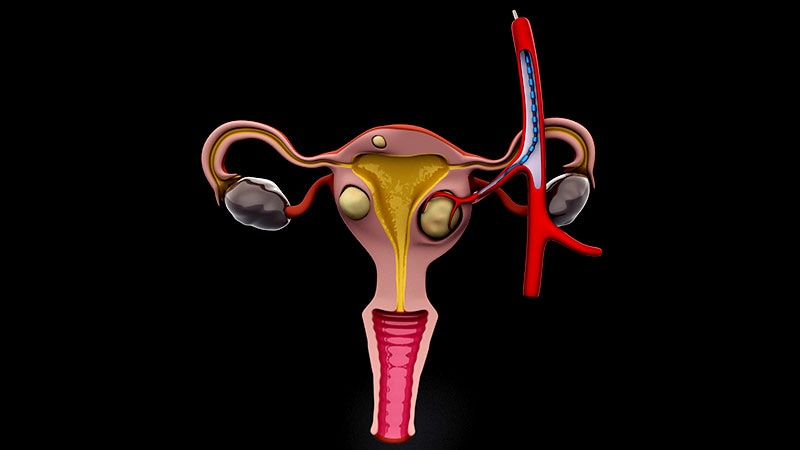High Success Rate of Uterine Embolization in Postpartum Hemorrhage
Khái niệm cốt lõi
Uterine artery embolization (UAE) is highly successful in controlling postpartum bleeding, reducing the need for hysterectomies.
Tóm tắt
TOPLINE:
Study at the Society of Interventional Radiology Annual Scientific Meeting shows high success of UAE in controlling postpartum bleeding.
METHODOLOGY:
UAE involves injecting particles to block blood flow in uterine arteries.
Retrospective review of 66 patients who underwent UAE for postpartum hemorrhage.
Median time between hemorrhage and UAE was 4 hours, up to 15 days.
Patients lost a median of 2790 mL of blood, with over 80% receiving pre-embolization transfusion.
TAKEAWAY:
94% success rate in hemorrhage control post-UAE.
Higher blood loss pre-UAE linked to post-embolization syndrome.
19% infertility rate post-UAE.
Higher fibrinogen levels pre-embolization associated with better hemorrhage control.
IN PRACTICE:
Obstetricians should involve interventional radiologists early for UAE in managing postpartum hemorrhage.
SOURCE:
Led by Younes Jahangiri, MD, at Michigan State University/Corewell Health.
LIMITATIONS:
Retrospective review with a small sample size.
DISCLOSURES:
No disclosures reported.
Hysterectomy Avoided With Uterine Embolization After Birth
Thống kê
UAE had a high rate of success in controlling postpartum bleeding.
Patients lost a median of 2790 mL of blood.
Successful hemorrhage control was achieved in 94% of patients.
Overall infertility rate after UAE was 19%.
Trích dẫn
"Based on these findings, we would encourage obstetricians to involve interventional radiologists early, to be ready to perform UAE if more conservative approaches are not managing postpartum hemorrhage." - Study Source
Thông tin chi tiết chính được chắt lọc từ
by Lauren Arcur... lúc www.medscape.com 03-22-2024
https://www.medscape.com/viewarticle/hysterectomy-avoided-uterine-embolization-after-birth-2024a10005d8
Yêu cầu sâu hơn
How can the findings of this study impact current postpartum hemorrhage management practices?
The findings of this study suggest that uterine artery embolization (UAE) can be a highly effective method for controlling postpartum bleeding, potentially avoiding the need for hysterectomies in many cases. This could lead to a shift in current postpartum hemorrhage management practices towards earlier involvement of interventional radiologists to consider UAE as a treatment option. By recognizing the success rate of UAE in managing postpartum hemorrhage, obstetricians may be more inclined to explore this minimally invasive procedure as a viable alternative to more invasive surgical interventions.
What potential drawbacks or risks might be associated with the widespread adoption of UAE for postpartum hemorrhage?
While UAE has shown promising results in controlling postpartum hemorrhage, there are potential drawbacks and risks associated with its widespread adoption. Some of these include the risk of post-embolization syndrome, which can manifest as fever, abdominal pain, and nausea. Additionally, the overall infertility rate after UAE was found to be 19%, which could be a significant concern for women desiring future pregnancies. Furthermore, the long-term effects of UAE on fertility and uterine health need to be carefully considered before widespread adoption, as more research is needed to fully understand the implications of this procedure on reproductive outcomes.
How can advancements in interventional radiology further improve outcomes in obstetrics and gynecology beyond postpartum hemorrhage cases?
Advancements in interventional radiology have the potential to revolutionize outcomes in obstetrics and gynecology beyond postpartum hemorrhage cases. For instance, the development of new techniques and technologies in interventional radiology can enhance the management of various gynecological conditions such as fibroids, adenomyosis, and pelvic congestion syndrome. By leveraging minimally invasive procedures like UAE, interventional radiologists can offer alternative treatment options for women with gynecological issues, reducing the need for more invasive surgeries and improving overall patient outcomes. Additionally, the collaboration between interventional radiologists and obstetricians/gynecologists can lead to a more comprehensive and multidisciplinary approach to women's health, ultimately advancing the field of obstetrics and gynecology towards more personalized and effective care.
0
